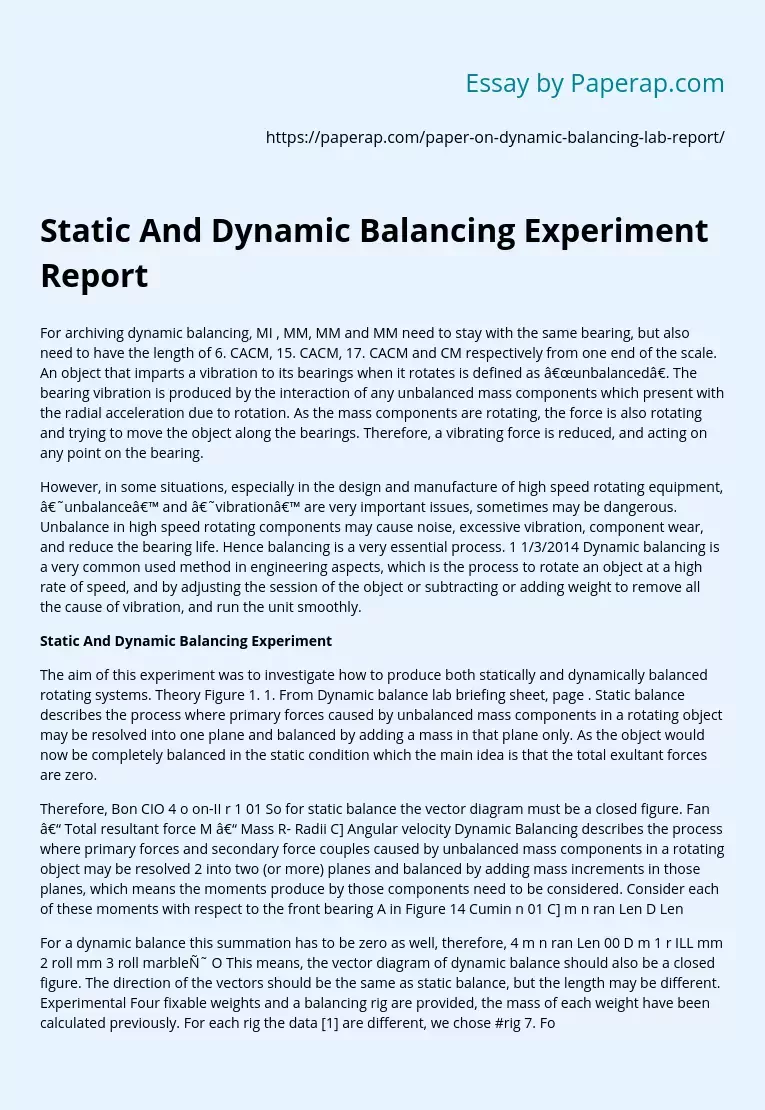Static And Dynamic Balancing Experiment Report
For archiving dynamic balancing, MI , MM, MM and MM need to stay with the same bearing, but also need to have the length of 6. CACM, 15. CACM, 17. CACM and CM respectively from one end of the scale. An object that imparts a vibration to its bearings when it rotates is defined as “unbalanced”. The bearing vibration is produced by the interaction of any unbalanced mass components which present with the radial acceleration due to rotation. As the mass components are rotating, the force is also rotating and trying to move the object along the bearings.
Therefore, a vibrating force is reduced, and acting on any point on the bearing.
However, in some situations, especially in the design and manufacture of high speed rotating equipment, ‘unbalance’ and ‘vibration’ are very important issues, sometimes may be dangerous. Unbalance in high speed rotating components may cause noise, excessive vibration, component wear, and reduce the bearing life. Hence balancing is a very essential process. 1 1/3/2014 Dynamic balancing is a very common used method in engineering aspects, which is the process to rotate an object at a high rate of speed, and by adjusting the session of the object or subtracting or adding weight to remove all the cause of vibration, and run the unit smoothly.
Static And Dynamic Balancing Experiment
The aim of this experiment was to investigate how to produce both statically and dynamically balanced rotating systems. Theory Figure 1. 1. From Dynamic balance lab briefing sheet, page . Static balance describes the process where primary forces caused by unbalanced mass components in a rotating object may be resolved into one plane and balanced by adding a mass in that plane only.
As the object would now be completely balanced in the static condition which the main idea is that the total exultant forces are zero.
Therefore, Bon CIO 4 o on-II r 1 01 So for static balance the vector diagram must be a closed figure. Fan – Total resultant force M – Mass R- Radii C] Angular velocity Dynamic Balancing describes the process where primary forces and secondary force couples caused by unbalanced mass components in a rotating object may be resolved 2 into two (or more) planes and balanced by adding mass increments in those planes, which means the moments produce by those components need to be considered. Consider each of these moments with respect to the front bearing A in Figure 14 Cumin n 01 C] m n ran Len D Len
For a dynamic balance this summation has to be zero as well, therefore, 4 m n ran Len 00 D m 1 r ILL mm 2 roll mm 3 roll marbleј O This means, the vector diagram of dynamic balance should also be a closed figure. The direction of the vectors should be the same as static balance, but the length may be different. Experimental Four fixable weights and a balancing rig are provided, the mass of each weight have been calculated previously. For each rig the data [1] are different, we chose #rig 7. For static balance: 1 .
Set 2 bodies at arbitrary positions and orientations on the shaft, in this case is body 1 perpendicular to body 2. 2. Then use the Mr.. Values [1] (see appendix) of these two bodies to draw a vector diagram. And use compasses find out the intersection of mark and mark. The vector diagram will be closed if the system is statically balanced. Like Figure 1. Figure 1. Find out the intersection and get mark and mark. 3 3. Find out the bearing of each Mr.. By using protractor, and record the results as shown in Figure 2.
Set the equipment in those degrees, Figure 3. After that, static balance have been archived. Figure 2. The table of bearing Figure 3. Set rig. For dynamic balance: 4. Using the vector diagram of statically balancing (Figure 1 and make a parallel nine to any Mr.. Vectors (In this case is mark) to allow determination of the axial positions of the other two bodies to achieve dynamic balance. The dynamic vector diagram will be a distorted version of the static diagram because the lengths of the vectors are now the Mrs.. Values. Figure 4.
Dynamic balancing vector diagram 5. Measure each length of the new diagram, record as Mr.., and use = D to find out L values 6. Substructure the smallest L value form each values get L’ values, then scale L’ values to a appropriate value to get L” values (L” should fit the scale of the rig, in this case 3 < L” < 19). Figure 5. Table of data 5 Figure 6. Scale of rig. 7. Finally set the equiment in length with L”, and use the same angle in static balancing (Figure 2. ), turn on the motor to check dynamic balancing archived.
Static And Dynamic Balancing Experiment Report. (2019, Dec 05). Retrieved from https://paperap.com/paper-on-dynamic-balancing-lab-report/

